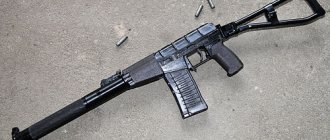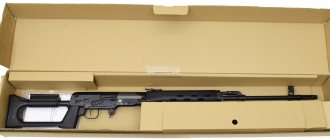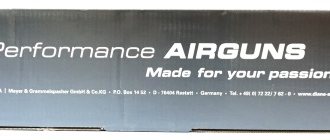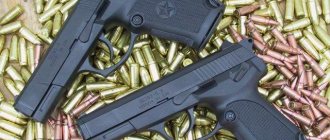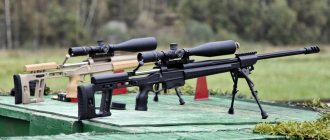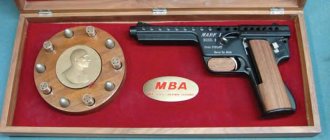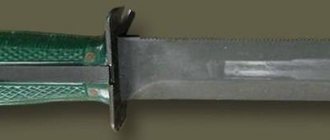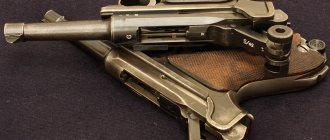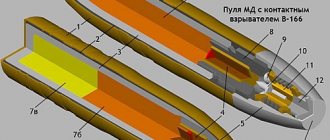The bullet is a striking element. Its flight range depends on the specific gravity of the material from which it is made.
In addition, this material must be plastic for cutting into the rifling of the barrel. This material is lead, which has been used to make bullets for several centuries. But a soft lead bullet, with an increase in the powder charge and pressure in the barrel, breaks off the rifling. The initial speed of a solid lead bullet from a Berdan rifle did not exceed 420-430 m/s, and this was the limit for a lead bullet. Therefore, they began to enclose a lead bullet in a shell made of a more durable material, or rather, they began to pour molten lead into this durable shell. Such bullets used to be called double-layer. With a two-layer device, the bullet retained as much weight as possible and had a relatively strong shell.
The bullet casing, made of a material stronger than the lead that filled it, prevented the bullet from breaking off the rifling under strong pressures inside the barrel and made it possible to sharply increase the initial speed of the bullet. Moreover, with a strong shell, the bullet deformed less when hitting the target and this improved its penetrating (piercing) effect.
Bullets consisting of a dense shell and a soft core (lead filling) appeared in the 70s of the 19th century following the invention of smokeless powder, which provided increased operating pressure in the barrel. This was a breakthrough in the development of firearms, which made it possible in 1884 to create the world's first and very successful famous Maxim machine gun. The jacketed bullet provided increased survivability of rifled barrels. The fact is that soft lead “enveloped” the walls of the barrel and clogged the rifling, which sooner or later caused the barrels to swell. To prevent this from happening, lead bullets were wrapped in salted thick paper, but this still did not help much. In modern small-caliber weapons that fire unsheathed lead bullets, in order to avoid enveloping the lead, the bullets are coated with special technical lard.
The material from which the bullet casing is made must be plastic enough so that the bullet can cut into the rifling, and strong enough so that the bullet does not break off when moving along the rifling. In addition, the material of the bullet shell should have the lowest possible coefficient of friction in order to wear out the barrel walls less and be resistant to rust.
All these requirements are most fully met by cupronickel - an alloy of 78.5-80% copper and 21.5-20% nickel. Bullets with nickel silver jackets have proven themselves in service better than any other. But cupronickel was very expensive to mass produce ammunition.
Bullets with nickel silver jackets were produced in pre-revolutionary Russia. During the First World War, in the absence of nickel, bullet casings were forced to be made of brass. During the Civil War, both the Reds and the Whites made ammunition from whatever they could find. The author had occasion to see cartridges produced in those years with bullet casings made of brass, thick copper and mild steel.
In the Soviet Union, bullets with cupronickel jackets were produced until 1930. In 1930, instead of cupronickel, low-carbon mild steel clad (coated) with tombac began to be used for the manufacture of jackets. Thus, the bullet shell became bimetallic.
Tompak is an alloy of 89-91% copper and 9-11% zinc. Its thickness in the bimetallic bullet casing is 4-6% of the shell wall thickness. The bimetallic bullet casing with a tombac coating generally satisfied the requirements, although it was somewhat inferior to cupronickel casings.
Due to the fact that the production of tombak coating requires scarce non-ferrous metals, before the war the USSR mastered the production of shells from cold-rolled low-carbon steels. These shells were coated with a thin layer of copper or brass using an electrolytic or contact method.
The core material in modern bullets is soft enough to facilitate insertion of the bullet into the rifling and has a fairly high melting point. For this, an alloy of lead and antimony is used in a ratio of 98-99% lead and 1-2% antimony. The admixture of antimony makes the lead core somewhat stronger and increases its melting point.
The bullet described above, which has a jacket and a lead core (filling), is called ordinary. Among ordinary bullets there are solid ones, for example the French solid tombac bullet (diagram 113), the French elongated solid aluminum bullet (4 in diagram 114), as well as lightweight ones with a steel core. The appearance of a steel core in ordinary bullets is caused by the requirement to reduce the cost of bullet design by reducing the amount of lead and reducing the deformation of the bullet in order to increase the penetrating effect. Between the bullet jacket and the steel core there is a lead jacket to facilitate cutting into the rifling.
Scheme 113 French solid tombac bullet
Scheme 114. Ordinary bullets:
1 - domestic light, 2 - German light; 3 - domestic heavy; 4 - French solid; 5 - domestic with a steel core; 6 - German with a steel core; 7 - English; 8 - Japanese A - annular groove - knurling for fastening the bullet in the sleeve
Old-made bullets are still in use today. There are light bullets of the 1908 model with a cupronickel silver jacket without an annular knurling to secure the bullet in the case (diagram 115) and a light bullet of the 1908-1930 model. with a steel shell clad with tombak, having an annular knurling for better fastening of the bullet in the cartridge case when assembling the cartridge (A in diagram 114).
Diagram 115. Light bullet of the 1908 model without knurling
The materials from which the bullet jacket is made wear the barrel differently. The main cause of barrel wear is mechanical abrasion, and therefore the harder the bullet jacket, the more intense the wear. Practice has shown that when shooting from the same type of weapon with bullets with different casings, manufactured at different times in different factories, the survivability of the barrel is different. When firing a bullet with a steel jacket, not clad with tombac, wartime release, barrel wear increases sharply. An uncoated steel shell tends to rust, which sharply reduces shooting accuracy. Such bullets were fired by the Germans in the last months of World War II.
The design of the bullet distinguishes between the head, leading and tail parts (diagram 116).
Diagram 116. functional parts of the 1930 model bullet:
A - head, B - leading, C - tail streamlined
The head of a modern rifle bullet has an elongated conical shape. The faster the bullet speed, the
its head part should be longer. This situation is dictated by the laws of aerodynamics. The elongated conical nose of the bullet has less aerodynamic drag when flying in the air. For example, the ogival blunt-pointed bullet of the three-line rifle of the first model produced before 1908 gave a 42% reduction in speed on the path from 25 to 225 m, and the pointed bullet of the 1908 model on the same path - only 18%. In modern bullets, the length of the bullet head is selected in the range from 2.5 to 3.5 weapon calibers. The leading part of the bullet cuts into the rifling.
The purpose of the leading part is to give the bullet reliable direction and rotational movement, as well as to tightly fill the grooves of the rifling of the barrel in order to eliminate the possibility of breakthrough of powder gases. For this reason, the thickness of the bullets is made with a larger diameter than the nominal caliber of the weapon (Table 38).
Table 38
Data on 7.62 mm rifle cartridges produced in the USSR at different times
As a rule, the leading part of the bullet is cylindrical; sometimes, for smooth cutting, the leading part of the bullet is given a slight taper. To better direct the movement of the bullet along the bore and to reduce the likelihood of it falling off the rifling, it is more advantageous to have a longer leading part; moreover, its longer length increases the accuracy of the fire. But as the length of the leading part of the bullet increases, the force required to insert the bullet into the rifling increases. This can lead to transverse rupture of the shell. In terms of barrel survivability, protecting the casing from rupture and ensuring better air flow during flight, a shorter leading part is more advantageous.
A long leading part wears out the barrel more intensively than a short leading part. When firing the old Russian blunt-pointed bullet with a longer leading part, the survivability of the barrels was half as much as when firing the new pointed bullet of the 1908 model with a shorter leading part. In modern practice, the accepted limits for the length of the leading part are from 1 to 1.5 caliber sizes.
From the point of view of shooting accuracy, it is unprofitable to take the length of the leading part less than one diameter of the barrel bore along the rifling grooves. Bullets of shorter length than the bore diameter along the rifling give greater spread.
In addition, reducing the length of the leading part leads to the possibility of it breaking off the rifling, causing the bullet to fly incorrectly in the air and deteriorating its seal. When the leading part of the bullet is short, gaps are formed between the bullet and the bottom of the rifling groove. Hot powder gases with solid particles of unburnt powder rush into these gaps at high speed, which literally “lick” the metal and dramatically increase barrel wear. A bullet that does not travel tightly along the barrel, but “walks” along the rifling, gradually “breaks” the barrel and worsens the quality of its further operation.
The rational relationship between the length of the leading part of the bullet and the diameter of the bore along the rifling grooves is also selected depending on the material of the bullet casing. Bullets with a jacket material that is softer than steel may have a leading length slightly greater than the rifling diameter of the barrel. This value can be no more than 0.02 caliber in rifling.
Fastening the bullet to the case is carried out by rolling or crimping the barrel of the case into the annular knurling of the bullet, which is usually done closer to the front end of the leading part. The muzzle of knurled steel cases will not “remove chips” and deform the chamber when a cartridge is fed into it.
A lot depends on how the bullet is mounted in the case. With a weak fastening, boost pressure does not develop; with a very dense fastening, the gunpowder burns in a constant volume of the cartridge case, which causes a sharp jump in the maximum pressure in the barrel, up to rupture. When shooting cartridges with different bullet rolls, there will always be a scatter of bullets in height.
The tail of the bullet can be flat (like the light bullet of the 1908 model) or streamlined (like the heavy bullet of the 1930 model) (see diagram 116).
